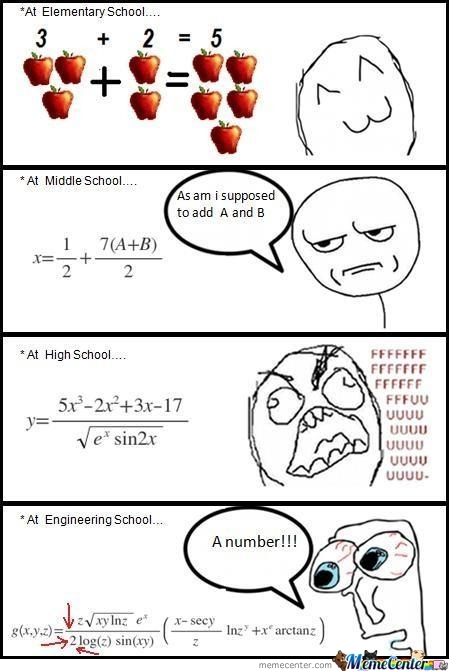Before we begin our journey to understand math, we must first start with the basic principles of algebra. What is a variable?
A variable, in its simplest, is a character representation of a number. For example, in the equation:
\(x+2=3\)
There is one variable, ( \(x\) ). To solve for this variable (which is what we will normally be doing when given an equation), we must first isolate it. To do this, we move all factors in the equation to the opposite side of the equal sign.
\(x=3-2\)
\(x=1\)
Although this is a relatively simple equation, it demonstrates a basic principle of solving equations: the isolation of variables. Now that you know what variables are, you can know the deep, dark secret of math: variables are love, variables are life. You can run, but you can't hide from variables. They're everywhere. For anyone going into engineering (or any math-heavy field in university), you will seldom see a number; everything will become variables. Thus, we can confirm the validity of the following meme:
At this point, you may be looking at the equations in the meme and become overwhelmed with the thought that you are diving into the terrifyingly deep field of mathematics. Don't be discouraged, if you tackle math in small steps, you'll quickly be surprised by how far you get with relative ease.
There are a few things to keep in mind when working with variables. We will now go through a few rules you should be aware of to ensure your equations are always valid.
When attempting to add or subtract two or more variables, follow these rules:
-
The variables must be the same, i.e.:
\(x \neq y\)
-
The variables must have the same exponent, for example:
\(x^{2} + x^{3} \neq x^{5}\)
but
\(x^{2} x^{3} = x^{5}\)
When attempting to multiply or divide two or more variables, follow these rules:
-
The variables must be the same, i.e.:
\(x \neq y\)
-
The exponents of the variables are added if you are multiplying, for example:
\(x^{4} x^{2} = x^{6}\)
and substracted if you are dividing, for example
\(x^{6} / x^{4} = x^{2}\)
When attempting to apply an exponent to a variable (or sum/product of variables), follow these rules:
-
The exponent is being applied to the variable is multiplied by the exponent of the variable itself, for example:
\((x^{4})^{2} = x^{8}\)
-
Exponents are not distributive when adding or subtracting, for example:
\((x^{2} + x^{3})^{2} \neq x^{4} + x^{6}\)
but they are when multiplying or dividing, for exmaple:
\((x^{2} x^{3})^{2} = x^{4}x^{6}\)
Now let's try some examples:
Addition
\(x + x^{2} + y + x + x^{2} = 0\)
\(x^{2} + x^{2} + x + x + y = 0\)
\((1 + 1) x^{2} + (1 + 1) x + y = 0\)
\(2x^{2} + 2x + y = 0\)
Multiplication
\(x y x^{2} x y^{4} = 0\)
\(x x x^{2} y y^{4} = 0\)
\(x^{(1+1+2)} y^{(1+4)} = 0\)
\(x^{4} y^{5} = 0\)
Exponents
\((x^{4}/y^{6})^{3} = 0\)
\(x^{(4*3)}/y^{(6*3)} = 0\)
\(x^{12}/y^{18} = 0\)
Putting it all Together
\((x^{2} y^{3})^{4} / (x^{3} y^{2}) = 0\)
\((x^{(2*4)} y^{(3*4)})/(x^{3} y^{2}) = 0\)
\((x^{8} y^{12})/(x^{3} y^{2}) = 0\)
\(x^{(8-3)} y^{(12-2)} = 0\)
\(x^{5} y^{10} = 0\)
That's it! Now you have the tools needed to proceed to the next section. WARNING: be sure you understand all the above rules. They are vital to understanding the proceeding chapters!
